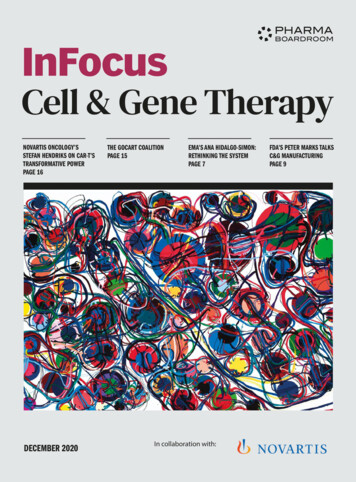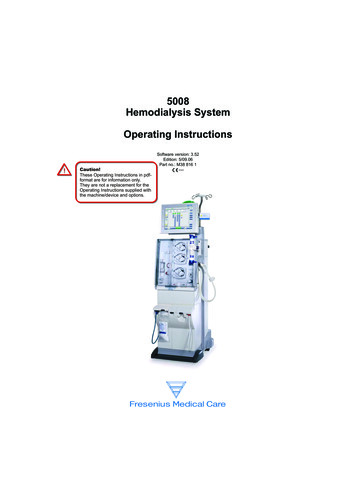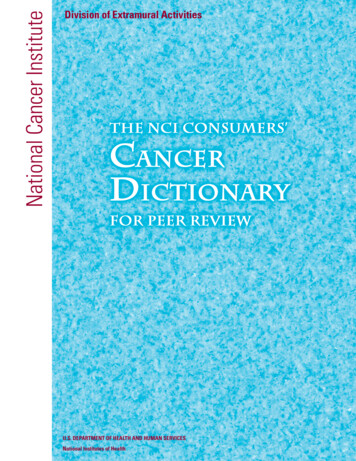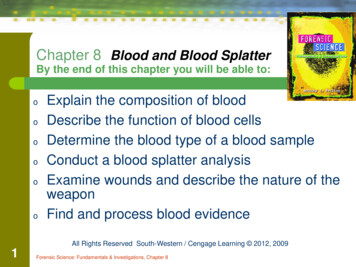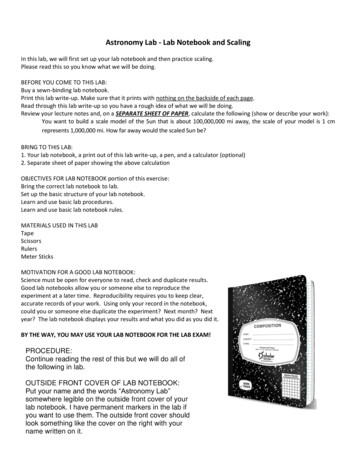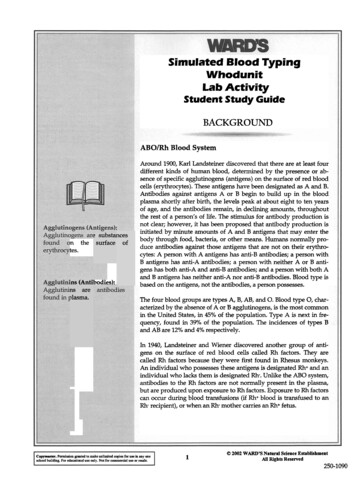
Transcription
Simulated Blood TypingWhodunitLab ActivityStudent Study GuideBACKGROUNDABOIRh Blood Systemsubstancessurface ofIln thetes.ins (Antibodies):ns are lasrna.Around 1900, Karl Landsteiner discovered that there are at least fourdifferent kinds of human blood, determined by the presence or absence of specific agglutinogens (antigens) on the surface of red bloodcells (erythrocytes).These antigens have been designated as A and B.Antibodies against antigens A or B begin to build up in the bloodplasma shortly after birth, the levels peak at about eight to ten yearsof age, and the antibodies remain, in declining amounts, throughoutthe rest of a person's of life. The stimulus for antibody production isnot clear; however, it has been proposed that antibody production isinitiated by minute amounts of A and B antigens that may enter thebody through food, bacteria, or other means. Humans normally produce antibodies against those antigens that are not on their erythrocytes: A person with A antigens has anti-B antibodies; a person withB antigens has anti-A antibodies; a person with neither A or B antigens has both anti-A and anti-B antibodies; and a person with both Aand B antigens has neither anti-A nor anti-B antibodies. Blood type isbased on the antigens, not the antibodies, a person possesses.The four blood groups are types A, B, AB, and 0. Blood type 0, characterized by the absence of A or B agglutinogens, is the most commonin the United States, in 45% of the population. Type A is next in frequency, found in 39% of the population. The incidences of types Band AB are 12%and 4% respectively.In 1940, Landsteiner and Wiener discovered another group of antigens on the surface of red blood cells called Rh factors. They arecalled Rh factors because they were first found in Rhesus monkeys.An individual who possesses these antigens is designated Rh and anindividual who lacks them is designated Rh-. Unlike the ABO system,antibodies to the Rh factors are not normally present in the plasma,but are produced upon exposure to Rh factors. Exposure to Rh factorscan occur during blood transfusions (if Rh blood is transfused to anRh- recipient), or when an Rh- mother carries an Rh fetus.Copymanta. Pamission graated to make unlimited q i s for usa in any meschool building For educsdmal use mly. Not for mmmadaluse or resale.18 2002 WARD'S Natnral Science EstablishmentAU Rights Reserved250-1090
Figure 1Antibodiesin PlasmaCan GiveBlood ToCan ReceiveBlood FromNeither Anti-A nor Anti-B0Neither A nor BDID YOU KXTnTA'*I Y V V Y :pan of a red: 120 dayBoth Anti-A and Anti-BThere is a simple test to determine blood type, performed with antisera containing high levels of anti-A, anti-B and anti-Rh agglutinins.Several drops of each kind of antiserum are added to separate samples of blood. If agglutination (clumping) occurs only in the suspension to which the anti-A serum was added, the blood type is A. If agglutination occurs only in the anti-B mixture, the blood type is B. Agglutination in both samples indicates that the blood type is AB. Theabsence of agglutination in any sample indicates that the blood typeis 0.Any sample that agglutinates in the presence of anti-Rh serum isconsidered Rh .Agglutination Reaction of ABO Blood-Typing SeraReactionAnti-A SerumAnti-B SerumAgglutinationNo AgglutinationNo AgglutinationNo AgglutinationM make unlimited copiesfor use in my meschool building For edudmal use only. Not for wmmerdal use or resale.INo Agglutination6 2002 WARD'S Natural Science EstablishmentAll Rights Reserved
Importance of Blood TypingAs noted in the table above, people can receive transfusions of onlycertain blood types, depending on the type of blood they have. If incompatible blood types are mixed, erythrocyte destruction, agglutination and other problems can occur. For instance, if a person withType B blood is transfused with blood type A, the recipient's anti-Aantibodies will attack the incoming type A erythrocytes. The type Aerythrocytes will be agglutinated, and hemoglobin will be releasedinto the plasma. This problem may not be serious, unless a largeamount of blood is transfused.-DII1YOU Ktlnnrlmed blood cells. TI?eresma in clod,diespresent.Blood type, an inherited characteristic, may also be used in medicolegal situations involving identification of disputed paternity. A comexclude the man as a possible parent. Blood typing does not provethat an individual is the faker of a child; it merely indicates whetheror not he is a possible parent. For example, a child with a blood typeof AB, whose mother is type A, could not have as a father a manwhose blood type is 0.Whenever blood has been shed in a criminal act, the identificationand typing of the blood stains are of primary importance to the crimescene investigator. The ABO blood groups are used to screen out possible suspects involved in the crime. The first step in the investigationis to distinguish the bloodstains from other similar looking com.alongpounds such as fruit juices, jam, chemicals, paint, e t Secondly,with a number of sophisticated tests to determine the sex of the individual from which the blood came, and the age of the blood stain, asimple blood typing test is also performed. Although a positivematch of the suspect's blood type is not sufficient to convict someoneof a crime, it is one type of evidence that is often obtained during acrime investigation.ICopymnter. Permission granted to make unlimited copies for use in any meschool buildin& For edutatioal u.nl Not for commercial w or resale.I8 2002 WARD'S Natural Science EstablishmentAH Rights Reserved
Assume the role of a forensics lab technicianExamine suspected blood evidence found at a crime sceneConfirm that the evidence is real bloodPerform the ABO/Rh procedure to determine the blood typeRelate the evidence to four possible suspectsf1b YOU KNOW?3arnels a:nd their relatives arehe only mamrrlals havwal red 1: load celLs.MATERIALSMATERIALS NEEDED PER GROUP4Pieces of stained cloth squares6Blood typing trays18 Toothpicks1 Microscope slide1 Compound microscopeSHARED MATERIALS11111111Coppuairr. Psndssion granted to make unlimited wpies for use in my oneschool building For educational use only. Not for commercial use or resale.Vial, WARD'S Simulated Blood - Victim's bloodVial, WARDS Simulated Blood - Suspect #1Vial, WARD'S Simulated Blood - Suspect #2Vial, WARD'S Simulated Blood - Suspect #3Vial, WARD'S Simulated Blood - Suspect #4Vial, anti-A serumVial, anti-B serumVial, anti-Rh serum48 ZOO2 WARD'S Natural Science EstablishmentAll Rights Reserved
PROCEDUREAlthough WARD'S Simulated Blood is completely safe, nonbiological, and non-toxic, you should wear the proper personalprotective equipment to mimic the experience of an actual hematology laboratory.Scenario:YOU KI!e mid-l!.rculatingthe bodj1Crime investigators were called to the scene of a burglary. Mr. Smithhad come home, only to find someone robbing his apartment. As thecriminal rushed to leave the apartment, he ran into a glass door cutting his arm and tearing his shirt. The crime investigators were ableto remove small pieces of clothing that appeared to be blood stainedfrom the broken glass door. p e blood samples from the crime scene,onethe or along with your classmates, have been chosen to provide this lastpiece of evidence and determine which of the suspects is the burglar.Part A. Microscopic InvestigationThe first step in the investigation is to distinguish the blood stainsfrom other similar looking compounds such as fruit juices, foods,chemicals, paint, etc.1. Use the provided piece of stained cloth found at the scene of thecrime. Place the stained cloth flat on a microscope slide and placeone drop of water on it.2. View the cloth under low and high power (400X)for any cluesthat would lead you to prove that the stain on the cloth is indeedblood.3. Describe your observations and state your conclusion in Table 1in the Analysis section. State whether or not you believe the sample is stained with blood.Permission granted to make unlimited copies for use in any meschool building For educaiimal use only.Not for commercialuse. or resale.Cappus*.50 2002 WARD'S Natwal Science EstablishmentA1 Rights Reserved
Part B. ABOIRh Blood TypingYou will now determine the blood type of the victim, the four suspects, and the blood found at the scene of the crime.1. Use a wax pencil to label each of your six blood typing trays asfollows:Tray #I: Crime sceneTray #2: VictimTray #3: Suspect #1Tray #4: Suspect #2Tray #5: Suspect #3Tray #6: Suspect #42. To determine the type of blood found at the crime scene, place apiece of the blood stained cloth, provided by your teacher, in eachof the A, B, and Rh w e b of blood typing Tray #1 labeled "CrimesceneN.3. Place 3-4 drops of the simulated anti-A serum on the bloodstained cloth in the A well of the tray.Forensic' serologists studyblood, 1 load groups, and4. Place 3-4 drops of the simulated anti-B serum on the bloodstained cloth in each B well of the tray.5. Place 3-4 drops of the simulated anti-Rh serum on the bloodstained cloth in each Rh well of the tray.6. Obtain three toothpicks. Stir each sample of antiserum and bloodstained cloth with a separate clean toothpick for 30 seconds. Toavoid splattering the simulated blood, do not press too hard onthe typing tray.7. Observe the slide and record your observations in Table 2 of theAnalysis section. To confirm agglutination try reading textthrough the mixed sample. If you cannot read the text, assumeyou have a positive agglutinationreaction.nAgglutinationCopgrmster. P m s s i o n granted to make lml nutedwples for use m any oneschool blulLng For educauonal use only Not for wmmernal use or resale6No Agglutination8 2002 WARD'S Natural Science EstablishmentAU Rights Reserved
Once you have determined the type of moos founa at the scene of thecrime, you will then type the blood of the victim and four suspects.8. Place 3-4 drops of the victim's blood in each of the A, B, and Rhwells of Tray #2: Victim.9. Place 3-4 drops of Suspect #lls blood in each of the A, B, and Rhwells of Tray #3: Suspect #I.10. Place 3-4 drops of Suspect #2's blood in each of the A, B, and Rhwells of Tray #4: Suspect #2.11. Place 3-4 drops of Suspect #3's blood in each of the A, B, and Rhwells of Tray #5: Suspect #3.DID YOU KNOW?deteciion of trace bloodlrns at criime scent12. Place 3-4 drops of Suspect #4's blood in each of the A, B, and Rhwells of Tray #6: Suspect #4.13. Place 3-4 drops of the simulated anti-A serum in each A well onthe five trays.14. Place 3-4 drops of the simulated anti-B serum in each B well onthe five trays.15. Place 3-4 drops of the simulated anti-Rh serum in each Rh well onthe five trays.16. Stir each sample with a separate clean toothpick for 30 seconds.To avoid splattering the simulated blood, do not press too hardon the typing tray.17. Observe the slide and record your observations in Table 2. Toconfirm agglutination try reading text through the mixed sample.If you cannot read the text, assume you have a positiveagglutination reaction.WARD'S Simulated blood is non-biological and nontoxic and may beflushed down the drain.Copgmnster. Permissiongranted to make W t e d wp esfor use in any oneschool building For educatiooal use only Not for commercialuse or resale.70 2002 WARD'S Natural Science EstablishmentAll Rights Reserved
---.ctivityDate:ANALYSISTable 1ObservationsConclusionTable 2Blood SourceAnti-A SerumAnti-B SerumAnti-Rh SerumBlood TypeCrime SceneVictimSuspect 1Suspect 2Suspect 3Suspect 4Copym trx.Permision granted to make mdimited copies for use in my oneschool building For educationaluse only. Not for wmmerd use or resale.6 2002 WARD'S Natural Science EstablishmentAU Rights Reserved
1. As a forensics technician, the courts have asked you to summarize your findings to the jury. Explainwhat you would say in the space below (remember,it is your job to report the facts, not decide who2. How would you respond to the accused suspect's denial of having the blood type you identified,since he has proof that he had just received a blood transfusion with type 0 blood?3. Why is it necessary to type the victim's blood?4. a. Pick one of the following suspects:Suspect #1Suspect #2Suspect #3Suspect #4Suspect #:b. Using the information from from Figure 1and the data from your blood type analysis, what ABOagglutinogens are present on the suspect's red blood cells?c. What ABO agglutinins are found in the suspect's blood plasma?d. What is the suspect's blood type?e. If the suspect needed a blood transfusion, what blood types could he/she receive?f. What blood types could safely receive this suspect's blood?Copymnta. Permission granted to make unlimited copies for use in any meschool building FM educational use only. Not for c o m m d use M resale.6 2002 WARD'S Natural Science EstablishmentAU Rights Reserved
5. Create a graph or chart that depicts the percentages of each ABO blood type in the United States.6. Using the following graphic organizer, fiU in the properties which are unique to agglutinins in thebubbles on the right, properties common to both agglutinins and agglutinogens in the center bubbles and properties unique to agglutinogens in the bubbles on the left.DifferencesICopymaster. Permissimgranted to make rmlimited copis for pss in any meschwl building For & c a t i d use only. Not for commercial ure or maleSimilaritiesIDifferences8 ZOO2 WARD'S Natural Science EstablishmentAU Rights Reserved
.8.Az are agglutinins like security guards?You are a defense attorney representing the accused. Your client has been shown to have the sameblood type as that found at the scene of the crime. Explain to the jury why this information alone isnot enough to convict your client.9. As the client's attorney, you have also been provided with police videotape of the crime sceneanalysis. In the video, you notice that one of the investigating officers has a bandage on his hand.How could you use this evidence to your advantage?10. Blood typing in one method of gathering evidence at the scene of a crime. Describe at least twoother methods that can be used in the attempted identification of a gLulty suspect.11. Many times, a suspect may attempt to clean the area containing a blood stain at the scene of a crime.One tool utilized by forensic investigators is a substance called luminol. Research luminol on theinternet or at the library and explain how it may be used to aid investigators at a crime scene.Coppiaster. Permission granted to make uulimited copies for use in my oneschool building For eduoatimal use only.Not forconrm daluse or resale.11O 2002 WARD'S Natural Science EstablishmentAU Rights Resewed
certain blood types, depending on the type of blood they have. If in- compatible blood types are mixed, erythrocyte destruction, agglutina- tion and other problems can occur. For instance, if a person with Type B blood is transfused with blood type A, the recipient's anti-A antibodies will attack the incoming type A erythrocytes. The type A
